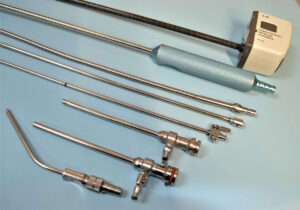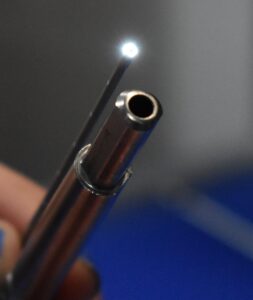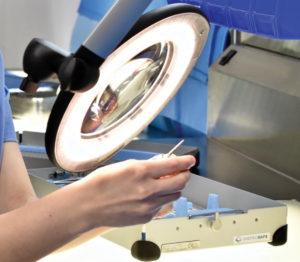
AORN Guidelines for Perioperative Practice: Defining and Achieving ‘clean’
Why do we need Guidelines?
Reprocessing a surgical instrument is a highly technical process. Guidance is needed for all the elements of reprocessing, from point of use pre-treatment to sterilization. If a nurse or technician fails to clean and sterilize instruments correctly, the outcome can be detrimental to patient safety. This is where AORN guidelines are critical.
AORN guidelines on ‘clean’
Determining if an instrument is ‘clean’ is more complicated than it seems. The AORN guidelines state that it can be difficult to ensure if an instrument is clean when it is more complex in construction and intended use..
“Reusable surgical instruments with complex designs (eg, powered devices, robotic instruments, instruments with narrow lumens) can present challenges to decontamination processes, and cleaning verification may be useful to evaluate cleaning effectiveness in these devices”
AORN eGuidelines+:2020 10.1
Staging for success: the impact of a department’s workflow on achieving ‘clean’
AORN recommends the department be set up to optimize unidirectional workflow. The sterile processing department should be set up like a one-way street, where instruments flow from point A to point B in a linear fashion. This guidance helps prevent cross-contamination and maintain ‘clean’ when it is achieved. Departments will also find recommendations for where clean vs. dirty items are handled:
“Perform cleaning and decontamination in an area separate from locations where clean items are handled”
AORN eGuidelines+:2020 2.2
As manual cleaning is foundational to achieving sterility, ensuring the decontamination sink can enable cleaning outcomes is critical.
“The decontamination area should be equipped with multiple sinks that are designated for soaking and cleaning, intermediate rinse, and final rinse; large enough to accommodate instrument trays; at an ergonomically correct height; and marked at the water level needed for cleaning solution measurement;”
AORN eGuidelines+:2020 2.5
Looking for a new reprocessing sink? Consider these 5 ways to identify the best sink for your department.
Manual Cleaning
Manual cleaning is the most important step for ensuring a device is clean, and if it is not performed properly, can compromise the device’s sterility. AORN states that cleaning can be done through manual or mechanical processes and that the device’s IFU should be consulted for best practice.
“Manual cleaning is often recommended for devices that cannot tolerate the action of mechanical cleaning or cannot be immersed (eg, power drills, delicate microsurgical instruments, flexible endoscopes, cameras).”
AORN eGuidelines+:2020 9.5
 Specifically, for lumened devices, AORN states:
Specifically, for lumened devices, AORN states:
” Flush lumens with cleaning solution and brush them with a brush of the length, diameter, type, and material specified in the device manufacturer’s IFU.”
AORN eGuidelines+:2020 9.4.5
Visual Inspection
While the AORN guidelines do not have a concrete outline to determine if an instrument is clean, they do state what can be done to ensure some definition of clean is achieved.
“Currently, there is no single standard of clean, nor is there a standard test for soil for surgical instruments. Efficacy of cleaning has traditionally been evaluated through visual inspection.”
AORN eGuidelines+:2020 10.1
Although subjective, visual inspection is one method reprocessing professionals have to determine quality of clean. Visual inspection with the naked eye is typically not sufficient. To address this issue, the AORN guidelines recommend lighted magnification is used to inspect.
“An instrument that appears clean to the naked eye may harbor debris that cannot be seen without magnification.”
AORN eGuidelines+:2020 10.2 ”
With magnification, technicians and nurses can help visualize the things our eyes alone cannot. Furthermore, lumened devices, and devices with narrow lumens especially, can pose a problem for assuring cleanliness. For this issue, AORN guidelines recommend a borescope or endoscopic camera be used.
“An endoscopic camera or borescope can facilitate identification of retained soil. Clinical soil retained after cleaning can impede subsequent disinfection and sterilization.”
AORN eGuidelines+:2020 10.3.4
One specific instrument was called upon by the guidelines to be connected to SSI’s (Surgical Site Infections) even after extenuating decontamination and sterilization processes had been performed: the Arthroscopic Shaver. The guidelines highly recommend using a borescope or endoscopic camera to inspect this device.
“In a 2007 case-control study, Tosh et al 102 reported on an outbreak of Pseudomonas aeruginosa SSI in seven patients on whom the same arthroscopic shaver was used. During investigation, the researchers found debris in a lumen of the shaver although the shaver had undergone repeated decontamination and sterilization procedures. The researchers concluded that the retained surgical debris allowed the bacteria to survive the sterilization process, and the subsequent use of the shaver was likely related to the SSI outbreak.”
AORN eGuidelines+:2020 10.3.3
Patient safety is the number one goal for any SPD or GI department. The processes technicians and nurses perform are imperative to upholding this sacred vow, but they are also mired with grey areas that leave much to interpretation by the departments. Consulting guidelines, such as AORN and consulting manufacturer’s IFU help departments to ensure they can achieve their number one goal, patient safety.
Looking for more information on how to ensure all devices are being properly cleaned and decontaminated? Read The Three Pillars of Effective Lumened Cleaning to learn what tasks support highly effective manual cleaning outcomes.





